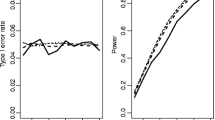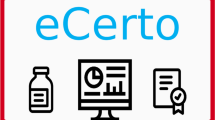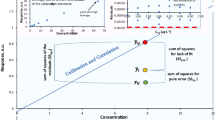Abstract
A PC-based interactive programme is described which is designed to help in suggesting the best estimate of the true value of an analyte content from results of collective studies aiming at deriving consensus values and/or reference material preparation by employing combined statistical and analytical considerations. The Grubbs, Dixon, Huber tests, and the coefficients of skewness and curtosis tests are used for outlier detection, the Bartlett, Cochran, and the standard error tests are employed for testing variance homogeneity testing and/or variance outliers identification, while the normality of results distribution is tested according to the Kolmogoroff-Smirnoff-Lilliefors and Shapiro-Wilk tests. One-way analysis of variance (ANOVA) is employed to test differences among means of results obtained in different conditions (laboratories, analytical methods, etc.) and to calculate the overall mean and its confidence interval accordingly. Points for an analytical discussion are given which should be considered prior to a decision whether a result of a trace element determination, identified as an outlier from statistical reasons, should be rejected.
Similar content being viewed by others
References
Taylor JK (1993) Standard Reference Materials Handbook for SRM Users NIST Spec Publ 260–100. US Government Printing Office, Washington, DC
de Goeij JJM, Kosta L, Byrne AR, Kučera J (1983) Anal Chim Acta 146:161
Byrne AR, Camara-Rica C, Cornelis R, de Goeij JJM, Iyengar GV, Kirkbright G, Knapp G, Parr RM, Stoeppler M (1987) Fresenius Z Anal Chem 326:723
Dybczynski R (1980) Anal Chim Acta 117:53
Mandel J, Paule RC (1970) Anal Chem 42:1194 and Corrections (1971) Anal Chem 43:1287
Fangmayer H, Haemers L, Larisse (1977) Statistical Approach for Collaborative Tests Reference Materials Certification Procedures. EUR 5621 en, CEC, Brussels-Luxembourg
Paule RC, Mandel J (1982) J Res NBS 87:377
Marchandise H, Colinet E (1983) Fresenius Z Anal Chem 316:669
Kallischnigg G, Müller J (1984) Fresenius Z Anal Chem 317:241
Smith R (1984) Talanta 31:537
Pszonicki L, Hanna AN, Suschny O (1984) IAEA/RL/112 Report on Intercomparison IAEA Soil-7. IAEA, Vienna
Lister B (1986) Anal Chim Acta 186:325
Davies PL (1988) Fresenius Z Anal Chem 331:513
Paule RC, Mandel J (1989) J Res NIST 94:197
Barnett V, Lewis T (1979) Outliers in statistical data. Wiley, New York
Doerffel K, Eckschlager K (1985) Optimum strategy of chemical analysis. SNTL, Prague (in Czech)
Johnson NL, Leone FC (1964), Statistics and experimental design in engineering and the physical sciences, vol. 1. Wiley, New York
Sachs L (1978), Applied statistics, A handbook of techniques, 5th ed. Springer, Berlin Heidelberg New York
Grubbs FE (1969) Ann Math Stat 21:27
Shapiro SS, Wilk MB (1965) Biometrika 52:591
Griepink B, Colinet E, Gonska H, Muntau H (1984) BCR Information, Report EUR 9251 EN, Brussels, Luxembourg
Likeš J, Laga J (1978) Basic statistical tables. SNTL, Prague (in Czech)
Hartley HO (1962) In: Ralston A, Wilf H (eds) Mathematical methods for digital computers. Wiley, New York
Mader P, Kučera J, Cibulka P, Miholová D (1989) Chem Listy 83:765
Kučera J, Mader P, Miholová D, Cibulka J, Poláková M, Kordík D (1990) Fresenius J Anal Chem 338:66
Kučera J, Soukal L (1993) Fresenius J Anal Chem 345:193
Kučera J, Mader P, Miholová D, Cibulka J, Kordík D (1995) Fresenius J Anal Chem (in press)
Šperlingová I, Dabrowská L, Kučera J, Tichý M (1995) Fresenius J Anal Chem (in press)
Guide to the expression of uncertainty in measurement (1992) ISO/TAG 4/WG 3, ISO, Geneve
Taylor BN, Kuyatt CE (1993) Guidelines for evaluating and expressing the uncertainty of NIST measurement results. NIST Technical Note 1297, Gaithersburg, MD
Quantifying Uncertainty in Analytical Measurements (1994) EURACHEM Committee Draft, Version: 4, EURACHEM Workshop, September 5–6, Graz
Author information
Authors and Affiliations
Rights and permissions
About this article
Cite this article
Kučera, J., Faltejsek, J. Interactive programme for evaluation of circular analyses (IPECA). Fresenius J Anal Chem 352, 80–86 (1995). https://doi.org/10.1007/BF00322302
Received:
Revised:
Accepted:
Issue Date:
DOI: https://doi.org/10.1007/BF00322302




